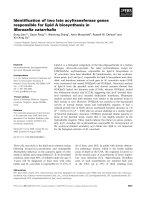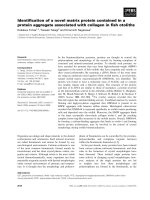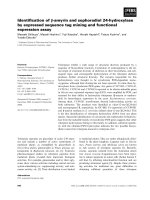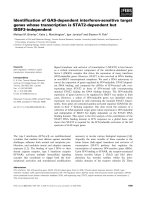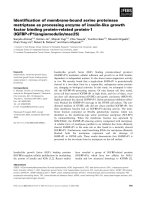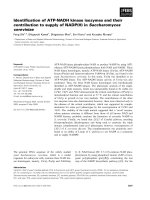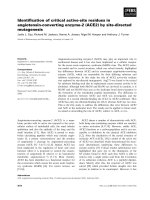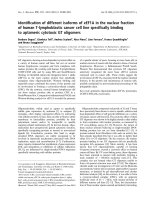Báo cáo y học: Identification of an element within the promoter of human selenoprotein P responsive to transforming growth factor-b ppt
Bạn đang xem bản rút gọn của tài liệu. Xem và tải ngay bản đầy đủ của tài liệu tại đây (283.53 KB, 6 trang )
Identification of an element within the promoter of human
selenoprotein P responsive to transforming growth factor-b
Volker Mostert
1
, Sandra Wolff
1
, Ingeborg Dreher
2
, Josef Ko¨ hrle
2
and Josef Abel
1
1
Medizinisches Institut fu
¨
r Umwelthygiene an der Heinrich-Heine-Universita
¨
tDu
¨
sseldorf Abteilung Experimentelle Toxikologie,
Du
¨
sseldorf, Germany;
2
Medizinische Poliklinik, Universita
¨
tWu
¨
rzburg, Wu
¨
rzburg, Germany
Selenoprotein P (SeP) is a plasma protein that contains up to
10 selenocysteine residues and accounts for about 50% of
total selenium in human plasma. We have previously shown
that SeP expression in the human liver cell line HepG2 is
inhibited by transforming growth factor (TGF)-b
1
on a
transcriptional level. Smad proteins are the transcriptional
mediators of TGF-b signalling and putative Smad-binding
elements (SBE) comprising the core sequence CAGACA are
present at two positions in the SeP promoter. The aim of our
study was to investigate whether Smad molecules are involved
in inhibition of SeP expression by TGF-b
1
and to locate the
promoter region critical for this effect. As seen in electro-
phoretic-mobility-shift assays, TGF-b
1
treatment led to
enhanced binding of nuclear proteins to a putative SBE from
the SeP promoter. Overexpression of Smad 3 and 4, but
not of Smad 2, resulted in a marked down-regulation
of SeP mRNA expression. Similar effects were observed
for luciferase expression under control of a human SeP-
promoter construct. Deletion as well as point-mutation of
putative SBEs led to a loss of promoter sensitivity towards
TGF-b
1
treatment. Hence, we demonstrated an involvement
of Smad 3 and 4 in transcriptional regulation of SeP by
TGF-b
1
and we were able to identify the TGF-b-responsive
element in the SeP promoter.
Keywords: selenoprotein P; transforming growth factor-b
1
;
Smad; promoter; CAGA box.
Selenoprotein P (SeP) is a selenocysteine-containing glyco-
protein that accounts for about 50% of total plasma selenium
in humans (reviewed in [1]). It differs from all other mam-
malian selenoproteins identified so far by its high selenium
content. From the mRNA of human SeP, it is predicted
selenocysteine will occur at 10 positions [2] whereas most
other selenoproteins contain only one selenocysteine residue
per subunit. The physiological function of SeP is not com-
pletely understood, but a role as a part of the body’s anti-
oxidant defence system seems most likely. SeP is secreted
into plasma mainly by the liver, but it is also highly
expressed in a number of different tissues indicating that
they also secrete it [3].
In vitro, SeP in human plasma can act as a protective
agent against the oxidation and nitration reactions mediated
by peroxynitrite, a potent oxidant generated in vivo [4].
Another in vitro study revealed a reducing activity of SeP
against phospholipid hydroperoxides, albeit with low
efficiency compared to the selenoenzyme phospholipid
hydroperoxide glutathione peroxidase [5]. The 5
0
flanking
region of the human SeP gene was shown to contain a
functional interferon (IFN)-g responsive element (GAS) and
negative regulation of the SeP promoter by pro-inflamma-
tory cytokines such as interleukin (IL)-1b and TNF-a was
found [6]. Expression of SeP mRNA and protein in human
hepatoma cells HepG2 is efficiently inhibited on a tran-
scriptional level by the anti-inflammatory cytokine trans-
forming growth factor (TGF)-b
1
[7].
Thus, SeP might be considered as a negative acute-phase
protein. Consistent with this assumption, selenium levels in
human plasma are drastically diminished in conditions of
systemic inflammatory response, sepsis, and burn injuries
[8,9]. As TGF-b
1
is secreted by activated macrophages [10]
and plays an important role in immunomodulation and
wound healing [11–13], it is possible that TGF-b
1
-mediated
down-regulation of SeP contributes largely to the decline in
plasma selenium observed in pathological conditions.
The Smad family of proteins has been found to transduce
TGF-b signals into the nucleus after being activated by the
TGF-b-receptor (TbR) complex [14]. Subsequently, they
bind directly to critical Smad-binding elements (SBEs) in
the promoter of TGF-b-inducible genes [15–18]. The human
SeP promoter (GenBank accession no. Y12262) also contains
two putative SBEs, therefore we sought to elucidate whether
these elements are functional at mediating the inhibitory
effect of TGF-b. SBEs have mostly been described for
TGF-b-inducible promoters, so far. However, Smad proteins
are also able to recruit transcriptional corepressors such as
5
0
-TG-3
0
-interacting factor (TGIF) [19] or c-Ski [20], which
could repress the transcriptional activity of promoters
bearing SBEs. In addition, we showed very recently the
involvement of TGIF, Smads and an SBE in the down-
regulation by TGF-b of the human aryl hydrocarbon
receptor [21].
Correspondence to J. Abel, Abteilung Experimentelle Toxikologie,
Medizinisches Institut fu
¨
r Umwelthygiene, Postfach 103751, D-40028
Du
¨
sseldorf, Germany. Fax: 1 49 211 3190 910,
Tel.: 1 49 211 3389 204, E-mail:
(Received 6 June 2001, revised 28 August 2001, accepted 01 October
2001)
Abbreviations: BMS, basal medium supplement; EMSA,
electrophoretic-mobility-shift assay; GAS, IFN-g-activation site; IFN,
interferon; IL, interleukin; SBE, Smad-binding element; SeP,
selenoprotein P; TGF, transforming growth factor; TGIF, 5
0
-TG-3
0
-
interacting factor; TbR, TGF-b receptor; PAI-1, plasminogen activator
inhibitor-1; SIRS, systemic inflammatory response syndrome.
Eur. J. Biochem. 268, 6176–6181 (2001) q FEBS 2001
The present study investigates whether Smad proteins are
involved in the down-regulation of SeP by TGF-b
1
and
explores where the critical TGF-b-responsive element is
located.
MATERIALS AND METHODS
Materials
Recombinant human TGF-b
1
and sodium selenite were
supplied by Sigma (Taufkirchen, Germany). RPMI 1640
medium was from PAA (Linz, Austria), penicillin/strepto-
mycin, basal medium supplement (BMS), fetal bovine
serum, sodium hydrogen carbonate, and
L-glutamine pur-
chased from Biochrom (Berlin, Germany). Other chemicals
were from Sigma unless otherwise stated.
Cell culture and treatment
The human hepatocarcinoma line HepG2 was cultured in
RPMI 1640 medium containing 10% fetal bovine serum, 1%
penicillin/streptomycin, 1 mg
:
mL
21
L-glutamine, and 0.15%
NaHCO
3
. Cells were maintained under standard conditions
at 37 8Cin5%CO
2
. Forty-eight hours before treatment,
cells were cultured in RPMI 1640 medium containing 5%
BMS, 1% penicillin/streptomycin, 1 mg
:
mL
21
L-glutamine,
and 0.15% NaHCO
3
and 250 nM sodium selenite to allow
selenoprotein expression. Cells were then treated as
indicated.
Plasmids and cell culture for transfection
The 1800-bp Bgl II/KpnI–SeP-promoter fragment was
isolated from the plasmid pBK15 [6] and subcloned into the
luciferase reporter gene plasmid pGL3basic revealing plasmid
BK4GL3. Restriction digestion with Kpn I/Pst I, blunt end
generation and religation removes the first CAGA-box and
59 bp of a sequence belonging to the pBluescriptSKII 1
plasmid used as a cloning vector during generation of
pBK15 [6]. The resulting plasmid is termed DBK4GL3 and
possesses only one complete CAGA box (Fig. 1)
Digestion of BK4GL3 with Kpn I/Sac I, blunt end gener-
ation with the Klenow fragment of DNA polymerase and
religation leads to removal of nucleotides 21868 to 21725,
yielding the construct termed DCAGA (Fig. 1). Expression
vectors for Smad 2, 3, and 4 in pcDNA3.1 (Invitrogen,
Karlsruhe, Germany) were a generous gift from G. Gross
(Gesellschaft fu
¨
r Biotechnologische Forschung, Braun-
schweig, Germany).
Transfections for reporter gene assays were performed
using the Dual Luciferase system (Promega, Mannheim,
Germany) using a reporter construct expressing Photinus
pyralis luciferase and the pRL-TK plasmid, which bears an
expression vector for Renilla reniformis luciferase as inter-
nal control for transfection efficiency [22]. The reporter
construct was present at 1 mg per well together with 0.15 mg
pRL-TK and 5 mg Transfectam reagent per well. In co-
transfection experiments, each Smad expression plasmid
was present at 0.5 mg per well, empty pGL3basic plasmid
was added to give a final plasmid concentration of 2 mg
where appropriate.
HepG2 cells were seeded into six-well plates (2 Â 10
5
cells per well). After 24 h, cells were transfected with the
indicated plasmids in 1 mL RPMI 1640 medium containing
5% BMS and allowed to rest for 4 h. Medium was then
replaced by 2 mL RPMI 1640 and after an additional 24 h
cells were either washed and lysed for luciferase assay or
treated with 100 p
M TGF-b
1
or vehicle (0.1% BSA in 4 mM
HCl) for 16 h prior to lysis. For RT-PCR analysis, cells were
allowed to rest for 48 h before RNA preparation.
Site-directed mutagenesis
The sequence CAGACA at position 21797 comprising the
putative SBE in the plasmid DBK4GL3 was mutated into
the sequence TACATA with a PCR-based strategy using the
QuikChange Site-Directed-Mutagenesis Kit (Stratagene, La
Jolla, CA, USA) according to the manufacturer’s instruc-
tion. Mutagenesis was achieved using the 45-nucleotide
primer 5
0
-GATAGGTACACAAAACCTTTTACATACTG
AGTTGTAGAAAGAAGG-3
0
(exchanged nucleotides are
in bold) and its complementary sequence.
Luciferase assays
Cell lysis was performed in 200 mL of passive lysis buffer
(Promega). Luciferase activities in cell lysates were deter-
mined using a LB 9505C luminometer (Berthold, Bad
Wildbad, Germany). Finally, P. pyralis luciferase activities
were normalized to R. reniformis luciferase activity and
protein content.
RT-PCR
For isolation of RNA from transfected cells, cells from three
wells treated equally were pooled prior to lysis. Semi-
quantitative RT-PCR was performed as described previously
[7]. SeP and GAPDH transcripts were coamplified using
gene-specific primers. Quantitative analyses were performed
using a phosphorimaging system and
QUANTITY ONE
software (Bio-Rad, Hercules, CA, USA).
Nuclear extracts
Nuclear extracts were prepared from HepG2 cells using a
modified protocol according to Dennler et al. [15]. Briefly,
confluent cells from 100 mm
2
culture flasks were washed
once with NaCl/P
i
and once with NaCl/P
i
containing 1 mM
Na
3
VO
4
and 5 mM NaF. After that, cells were scraped into
Fig. 1. Schematic representation of the SeP promoter constructs
used in this study. The numbering given refers to the major
transcription start site of the human SeP gene [6]. For simplicity, the
numbering is continued beyond the first nucleotide of the known SeP
promoter sequence at 21811.
q FEBS 2001 A TGF-b-responsive element in the SeP promoter (Eur. J. Biochem. 268) 6177
1 mL of ice-cold buffer A (20 mM Hepes pH 7.9, 20 mM
NaF, 1 mM Na
3
VO
4
,1mM Na
4
P
2
O
7
,1mM EDTA, 1 mM
EGTA, 1 mM dithiothreitol, 0.5 mM phenylmethanesulfonyl
fluoride, and 1 mg
:
mL
21
of each leupeptin and aprotinin).
The cells were allowed to swell on ice for 15 min and then
lysed by 30 strokes with a Teflon pestle. Nuclei were
pelleted by centrifugation (16 000 g, 30 s) and resuspended
in 150 mL buffer B (buffer A containing 420 m
M NaCl and
20% glycerol). The nuclear membrane was disrupted by 15
strokes with a Teflon pestle. The resulting suspension was
shaken for 30 min at 4 8C. After centrifugation (16 000 g,
20 min), the supernatants were aliquoted and stored at
280 8C until use.
Electrophoretic mobility shift assays
A putative SBE from the SeP promoter (nucleotides 21808
to 21778, 5
0
-ACAAAACCTTTCAGACACTGAGTTGTA
GAA-3
0
; SBE in bold) annealed to its complementary strand
was labelled using T4 polynucleotide kinase (Amersham
Pharmacia, Freiburg, Germany) and [g-
32
P]ATP. Binding
reactions contained 20 mg of nuclear extracts, 20 000 c.p.m.
(< 10 fmol) of the labelled probe, 20 m
M Hepes pH 7.9,
20 m
M KCl, 4 mM MgCl
2
, 0.1 mM EDTA, 20% glycerol,
0.8 m
M NaP
i
,4mM spermidine, and 3 mg poly(dI
:
dC).
Where indicated, 5 pmol unlabelled probe was included in
the binding reaction. Binding was performed for 15 min, at
this point 1 mL anti-(Smad-2-, 3-, or 4) IgG (500 mg
:
mL
21
)
were added when appropriate and incubated for another
15 min. Anti-Smad sera were a kind gift from P. ten Dijke,
Ludwig Institute for Cancer Research, Uppsala, Sweden
[23]. After binding, samples were separated on a 5% poly-
acrylamide gel containing 0.5 Â Tris/glycine/EDTA
(12.5 m
M Tris/HCl, pH 8.3, 95 mM glycine, 0.5 nM
EDTA). Radioactivity in the dried gel was visualized by
exposure to X-ray film.
RESULTS
Binding of a nuclear protein to a putative SBE after
treatment with TGF-b
1
Besides binding sites for well-established basal and regu-
latory transcription factors, which have been described
previously by Dreher et al. [6], the Smad-binding consensus
sequence CAGACA is present twice in the human SeP
promoter at position 21811 and 21797, respectively
(Fig. 1). As the CAGA box at position 21811 is located at
the very margin of the known SeP promoter sequence, the
5
0
flanking bases do not represent the context of the genomic
promoter but the sequence of the pBluescriptSKII 1
plasmid. Hence, we deemed the second CAGA-box at
21797 and its flanking sequences more suitable to design a
representative probe. Treatment with TGF-b
1
leads to
formation of a complex between a nuclear protein and the
labelled 30-bp DNA probe enclosing the putative SBE
(Fig. 2). The complex formation is apparent after 30 min
and further intensifies during 1 h of treatment. The specific
complex could be identified by displacement of the labelled
probe with a 500-fold molar excess of unlabelled probe
(lane 4).
As the so-called CAGA box has been described as a
Smad-binding element by several authors [15,16,24], we
sought to identify the protein component of the complex by
inducing a supershifted complex with Smad-specific
antibodies (Fig. 2, lanes 5–7). We were, however, not
successful using various commercially available antibodies
against human Smad isoforms or preparations provided
from published sources [23]. As it has been shown by other
groups that Smad oligomers can associate with different
partners [25,26], we hypothesized that Smad molecules in
the nuclear extract might be inaccessible to the antibody.
Effect of Smad overexpression on
SeP
mRNA levels
To examine whether Smad proteins as mediators of TGF-b
are capable of suppressing SeP mRNA expression, we
transfected HepG2 cells with Smad expression plasmids
and analysed SeP mRNA expression by RT-PCR. As shown
in Fig. 3, Smad 2 overexpression has no effect on SeP
mRNA expression. In contrast, Smad 3 and 4 alone and
in combination suppress the expression of SeP with the
most substantial effect exerted by Smad 3. Densitometric
evaluation reveals a suppression to < 26% of control values
after transfection with Smad 3. In this assay, no synergistic
effect of Smad 3 and 4 was observed but a weaker inhibition
of around 50%, similar to the effect of Smad 4 alone.
Transfection of Smad 2 along with Smad 4 abolished to
some extent the inhibition observed after transfection
with Smad 4 alone. RT-PCR analyses of Smad mRNA
expression, however, revealed that the expression levels
of the individual Smads did not vary substantially when
Fig. 2. Electrophoretic-mobility-shift assay with a probe encom-
passing the putative SBE from the SeP promoter. Lane 1 contains
nuclear extracts from untreated HepG2 cells, lane 2 and 3 include
extracts from cells treated with 100 p
M TGF-b
1
for 30 and 60 min,
respectively. Lane 4 depicts the protein preparation from lane 3
containing 500-fold molar excess of unlabelled probe. Lane 5, 6 and 7
each contain 500 ng of anti-Smad 2, 3 and 4-specific antibodies,
respectively, together with extracts from 60 min TGF-b
1
treatment.
6178 V. Mostert et al. (Eur. J. Biochem. 268) q FEBS 2001
either of the other isoforms were cotransfected (data not
shown).
Modulation of SeP promoter activity by overexpression of
Smad 2, 3, and 4
Overexpression of Smad proteins has been shown to activate
promoters of TGF-b-responsive genes [15,27]. As shown
above, overexpression of certain Smad proteins results in
inhibition of SeP mRNA expression. We investigated
whether Smad overexpression results in similar effects
on the SeP promoter construct BK4GL3 as does TGF-b
1
treatment [7]. Smad 2 did not significantly diminish
luciferase activity of the BK4GL3 construct whereas
Smad 3 and 4 alone as well as in combination caused a
marked inhibitory effect on luciferase expression (Fig. 4).
Mutagenesis of the putative SBEs
Restriction digestion of BK4GL3 with Sac I/Kpn I removes
91 bp from the 5
0
end of the SeP promoter sequence along
with a 53-bp stretch belonging to the pBluescriptSKII 1
plasmid. Religation yields a truncated promoter construct
without any CAGA boxes termed DCAGA. Cells transfected
with either BK4GL3 or DCAGA for 24 h were treated for
additional 16 h with 100 p
M TGF-b
1
. Basal promoter
activity was not affected by deletion of the CAGA boxes
(data not shown), whereas the marked TGF-b
1
responsive-
ness of the constructs BK4GL3 and DBK4GL3 was not
observed with DCAGA (Table 1) demonstrating that the
TGF-b
1
-responsive region of the SeP promoter resides in
this sequence stretch. Furthermore, the DCAGA construct is
insensitive to Smad overexpression (Fig. 4). It is also
noteworthy that when the first CAGA box in BK4GL3 is
destroyed by Kpn I/Pst I digestion yielding DBK4GL3,
TGF-b
1
responsiveness is slightly enhanced rather than
lowered (Table 1). Apparently, the first CAGA box is not
required for the down-regulation by TGF-b
1
of the SeP
promoter.
To define the actual TGF-b-responsive element more
accurately, we mutated three nucleotides of the remaining
functional CAGA box in the DBK4GL3 construct yielding
a construct we termed mDBK4GL3 (Fig. 1). The response
of mDBK4GL3 towards TGF-b
1
was only 19% of that
observed for DBK4GL3 (Table 1), indicating that the
presence of an intact consensus sequence CAGACA in
the SeP promoter is required for its down-regulation by
TGF-b
1
.
DISCUSSION
The inhibition by TGF-b
1
of SeP expression is to date the
only known regulation of this protein by a factor other than
the availability of selenium. TGF-b
1
has a variety of target
genes resulting in a manifold of effects on gene expression
and cell cycle (reviewed in [28]). The most significant
function of TGF-b appears to be the control of inflammatory
processesasTGF-b
1
-deficient mice show multifocal
inflammatory lesions as the main phenotype [29,30].
The Smad family of proteins has been characterized as
mediators of TGF-b signalling in recent years [14,23]. After
binding of TGF-b
1
to its cognate receptor, TbR, the so-
called activating Smads, which are represented by Smad 2
and 3 in mammals, are phosphorylated by the intrinsic Ser/
Thr-kinase activity of the activated receptor. Once
phosphorylated, Smads 2/3 bind to the ‘common pathway’
Smad 4 followed by translocation of this heterodimer into
the nucleus where target genes are modulated in their
transcriptional activity. Overexpression of Smad proteins
Fig. 4. Effect of transient Smad overexpression on the luciferase
expression of BK4GL3 (hatched bars) and DCAGA (open bars).
Cells were transfected as described in the legend to Fig. 3 except that
transfection time was only 24 h. Corrected luciferase activities are
given as percent of control transfection (means ^ SE, n ¼ 9). Asterisks
indicate statistical significance according to Student’s t-test
(P , 0.001).
Fig. 3. Effect of transient Smad overexpression on the expression of
SeP mRNA. SeP and GAPDH mRNA expression was analysed by
semiquantitative RT-PCR. Where indicated, cells were transfected for
48 h with 0.5 mg of the indicated plasmids. When appropriate, empty
pGL3basic plasmid was added to give a total plasmid concentration of
1 mg per well. The figures in the bottom row are means of two
independent replicates and represent densitometric values normalized
to the intensity of the coamplified GAPDH fragment.
Table 1. Relative TGF-b
1
responsiveness of the different reporter
constructs used in this study. HepG2 cells were transfected with 1 mg
of the indicated construct for 24 h and subsequently treated with
100 p
M TGF-b
1
for 16 h. The response of the individual reporter
constructs were normalized to the response of the construct DBK4GL3.
Values represent the means of two independent experiments.
Construct Insert length (bp) Relative TGF-b
1
response
BK4GL3 1855 0.79
DBK4GL3 1799 1.00
mDBK4GL3 1799 0.19
DCAGA 1711 0.00
q FEBS 2001 A TGF-b-responsive element in the SeP promoter (Eur. J. Biochem. 268) 6179
has been shown to mimic the activation of the TbR by its
agonists regarding the effects on target gene expression [31].
The sequence CAGACA has recently been described as the
consensus motif forming the Smad-binding element (SBE),
also known as the CAGA box. Among the genes bearing
functional SBEs in their promoter regions are plasminogen
activator inhibitor-1 (PAI-1) [15,32], JunB [16], collagen
type VII [17], and Smad 7 [18] all of them being strongly
induced by TGF-b
1
. The reports about functional SBEs in
these genes included electrophoretic-mobility-shift assays
(EMSAs) with successful supershift studies using anti-Smad
Ig. The fact that we were not able to unambiguously prove a
participation of Smad proteins in our EMSA by addition of
Smad-specific antibodies points towards the involvement of
additional nuclear factors which ultimately mediate the
transcriptional repression and conceal the antigenic deter-
minants of the Smad molecules. Numerous interactions
between Smads and other signalling molecules have been
reported (reviewed in [33]), therefore a variety of pathways
are worth considering for the interaction between Smad
proteins and the SeP promoter. For example, in TGF-b
1
-
treated human lung cancer cells A549, a recruitment of
histone deacetylase by Smad 2 was observed [26]. Histone
deacetylation leads to a tighter nucleosomal packing with a
general attenuation of the transcription of downstream
sequences. It is unclear whether Smad 3 or 4 can act in a
comparable fashion in HepG2 cells. The oncoprotein c-Ski
also binds to Smad 2/3 and recruits histone deacetylase
resulting in suppressed transcription [20,34]. However,
antibodies to these potential corepressors are not commer-
cially available so that we could not probe their involvement
directly using an EMSA approach.
Here, we describe the presence of a TGF-b-responsive
element in the promoter of the SeP gene. In addition, we
found the expression of SeP mRNA being attenuated by
overexpression of Smad 3 and 4 which mimics activation of
the TbR by TGF-b. We found that Smad 3 and 4, but not
Smad 2, confer inhibition of both SeP transcription and
promoter activity. This is in agreement with previous studies
showing that Smad 3 and 4, unlike Smad 2, bind to the
CAGA box [15,24]. In contrast, cotransfection with Smad 2
seems to interfere with the repression exerted by Smad 3 or
4 alone (Figs 3,4). As previous reports have demonstrated
the inability of Smad 2 to bind to the CAGA box [15,16],
one could speculate that Smad 2 binds transcriptional
corepressors without directing them to the CAGA box,
thereby reducing the amount of repressor molecules avail-
able for Smad 3 and 4 to recruit. Also, overexpression of
Smad 4 along with Smad 3 seems to attenuate the inhibitory
effect of the latter on SeP mRNA expression (Fig. 3). On the
other hand, in the luciferase reporter assays we conducted,
Smad 4 did not interfere with the inhibition of luciferase
activity by Smad 3 (Fig. 4). However, major differences
between the assessment of the SeP mRNA expression and
the measurement of luciferase activity exist. For example,
whereas in the first case the species assessed is the mRNA
(i.e. the respective cDNA) of SeP, the latter assay gauges
the activity of an enzyme derived from an unrelated
mRNA, namely that of luciferase. If the SeP mRNA would
be subject to any post-transcriptional regulation, it would
not be reflected by a change in luciferase activity and vice
versa. Thus, there is the potential for a different outcome of
mRNA expression studies and reporter gene assays.
In addition to the identification of Smad 3 and 4 as
regulators of SeP expression, we were able to demonstrate
that the presence of an intact CAGACA motif is required for
the inhibition of SeP promoter activity by TGF-b
1
. It is also
noteworthy that disruption of the first CAGA box (transition
from BK4GL3 to DBK4GL3) did not lead to an impaired
response to TGF-b. Furthermore, the total absence of
CAGA boxes in the construct DCAGA renders it insensitive
towards ectopical expression of Smad 3 and 4. This suggests
a key role of the CAGA box for the inhibition of SeP by
Smads as mediators of TGF-b
1
.
SeP is the most selenium-rich protein known to date. The
fact that SeP is negatively regulated by TGF-b
1
[7] and that
SeP levels in intensive care patients suffering from sepsis or
systemic inflammatory response syndrome (SIRS) show
drastically decreased plasma SeP levels [35] suggests that
SeP is regulated in a manner similar to a negative acute-
phase protein. In SIRS patients, low plasma selenium levels
were scarcely elevated after selenium supplementation [9]
indicating that a prime target protein of supplemental
selenium could be absent, which would be SeP in plasma
because of its large proportion among selenium-containing
plasma proteins. Furthermore, patients with major burns
exhibit an early and drastic decrease in plasma selenium
levels to around 35% of control values [8]. This decrease by
about 65% fairly corresponds to the proportion of plasma
selenium represented by SeP [36], thus, this effect could
principally be attributed to a decrease in SeP. As TGF-b
1
plays an important role in regulation of inflammatory
processes as well as in wound healing, an involvement of the
signalling pathway unveiled in our study appears likely.
ACKNOWLEDGEMENT
S.W. was supported by the Deutsche Forschungsgemeinschaft SFB
503-A5.
REFERENCES
1. Mostert, V. (2000) Selenoprotein P: properties, functions, and
regulation. Arch. Biochem. Biophys. 376, 433–438.
2. Hill, K.E., Lloyd, R.S. & Burk, R.F. (1993) Conserved nucleotide
sequences in the open reading frame and 3
0
untranslated region
of selenoprotein P mRNA. Proc. Natl Acad. Sci. USA 90,
537–541.
3. Dreher, I., Schmutzler, C., Jakob, F. & Ko
¨
hrle, J. (1997) Expression
of selenoproteins in various rat and human tissues and cell lines.
J. Trace Elem. Med. Biol. 11, 83–91.
4. Arteel, G.E., Mostert, V., Oubrahim, H., Briviba, K., Abel, J. &
Sies, H. (1998) Protection by selenoprotein P in human plasma
against peroxynitrite-mediated oxidation and nitration. Biol. Chem.
379, 1201–1205.
5. Saito, Y., Hayashi, T., Tanaka, A., Watanabe, Y., Suzuki, M., Saito,
E. & Takahashi, K. (1999) Selenoprotein P in human plasma as an
extracellular phospholipid hydroperoxide glutathione peroxidase.
Isolation and enzymatic characterization of human selenoprotein P.
J. Biol. Chem. 274, 2866–2871.
6. Dreher, I., Jakobs, T.C. & Ko
¨
hrle, J. (1997) Cloning and charac-
terization of the human selenoprotein P promoter. Response of
selenoprotein P expression to cytokines in liver cells. J. Biol. Chem.
272, 29364–29371.
7. Mostert, V., Dreher, I., Ko
¨
hrle, J. & Abel, J. (1999) Transforming
growth factor-b
1
inhibits expression of selenoprotein P in cultured
human liver cells. FEBS Lett. 460, 23–26.
6180 V. Mostert et al. (Eur. J. Biochem. 268) q FEBS 2001
8. Bertin-Maghit, M., Goudable, J., Dalmas, E., Steghens, J.P.,
Bouchard, C., Gueugniaud, P.Y., Petit, P. & Delafosse, B. (2000)
Time course of oxidative stress after major burns. Intensive Care
Med. 26, 800 – 803.
9. Forceville, X., Vitoux, D., Gauzit, R., Combes, A., Lahilaire, P. &
Chappuis, P. (1998) Selenium, systemic immune response
syndrome, sepsis, and outcome in critically ill patients. Crit.
Care Med. 26, 1536–1544.
10. Assoian, R.K., Fleurdelys, B.E., Stevenson, H.C., Miller, P.J.,
Madtes, D.K., Raines, E.W., Ross, R. & Sporn, M.B. (1987)
Expression and secretion of type beta transforming growth factor
by activated human macrophages. Proc. Natl Acad. Sci. USA 84,
6020–6024.
11. Kehrl, J.H., Roberts, A.B., Wakefield, L.M., Jakowlew, S.B., Sporn,
M.B. & Fauci, A.S. (1986) Transforming growth factor beta is an
important immunomodulatory protein for human B-lymphocytes.
J. Immunol. 137, 3855–3860.
12. Tsunawaki, S., Sporn, M., Ding, A. & Nathan, C. (1988) Deacti-
vation of macrophages by transforming growth factor-beta. Nature
334, 260–262.
13. Roberts, C.J., Birkenmeyer, T.M., McQuillan, J.J., Akiyama, S.K.,
Yamada, S.S., Chen, W T., Yamada, K.M. & McDonald, J.A.
(1988) Transforming growth factor-b stimulates the expression of
fibronectin and of both subunits of the human fibronectin receptor
by cultured human fibroblasts. J. Biol. Chem. 263, 4586 – 4592.
14. Heldin, C.H., Miyazono, K. & ten Dijke, P. (1997) TGF-beta
signalling from cell membrane to nucleus through SMAD proteins.
Nature 390, 465–471.
15. Dennler, S., Itoh, S., Vivien, D., ten Dijke, P., Huet, S. & Gauthier,
J.M. (1998) Direct binding of Smad3 and Smad4 to critical TGF
beta-inducible elements in the promoter of human plasminogen
activator inhibitor-type 1 gene. EMBO J. 17, 3091–3100.
16. Jonk, L.J., Itoh, S., Heldin, C.H., ten Dijke, P. & Kruijer, W. (1998)
Identification and functional characterization of a Smad binding
element (SBE) in the JunB promoter that acts as a transforming
growth factor-beta, activin, and bone morphogenetic protein-
inducible enhancer. J. Biol. Chem. 273, 21145–21152.
17. Vindevoghel, L., Kon, A., Lechleider, R.J., Uitto, J., Roberts, A.B.
& Mauviel, A. (1998) Smad-dependent transcriptional activation of
human type VII collagen gene (COL7A1) promoter by transform-
ing growth factor-beta. J. Biol. Chem. 273, 13053– 13057.
18. von Gersdorff, G., Susztak, K., Rezvani, F., Bitzer, M., Liang, D. &
Bo
¨
ttinger, E.P. (2000) Smad3 and Smad4 mediate transcriptional
activation of the human Smad7 promoter by transforming growth
factor beta. J. Biol. Chem. 275, 11320–11326.
19. Massague, J. & Wotton, D. (2000) Transcriptional control by the
TGF-beta/Smad signaling system. EMBO J. 19, 1745–1754.
20. Akiyoshi, S., Inoue, H., Hanai, J., Kusanagi, K., Nemoto, N.,
Miyazono, K. & Kawabata, M. (1999) c-Ski acts as a tran-
scriptional co-repressor in transforming growth factor-beta
signaling through interaction with Smads. J. Biol. Chem. 274,
35269–35277.
21. Wolff, S., Harper, P.A., Wong, J.M.Y., Mostert, V., Wang, Y. &
Abel, J. (2001) Cell-specific regulation of human arylhydrocarbon
receptor expression by transforming growth factor-b
1
. Mol.
Pharmacol. 59, 716– 724.
22. Do
¨
hr, O. & Abel, J. (1997) Transforming growth factor-beta 1
coregulates mRNA expression of aryl hydrocarbon receptor and
cell-cycle-regulating genes in human cancer cell lines. Biochem.
Biophys. Res. Commun. 241, 86–91.
23. Nakao, A., Imamura, T., Souchelnytskyi, S., Kawabata, M.,
Ishisaki, A., Oeda, E., Tamaki, K., Hanai, J., Heldin, C.H.,
Miyazono, K. & ten Dijke, P. (1997) TGF-beta receptor-mediated
signalling through Smad2, Smad3 and Smad4. EMBO J. 16,
5353–5362.
24. Zawel, L., Dai, J.L., Buckhaults, P., Zhou, S., Kinzler, K.W.,
Vogelstein, B. & Kern, S.E. (1998) Human Smad3 and Smad4 are
sequence-specific transcription activators. Mol. Cell 1, 611–617.
25. Sano, Y., Harada, J., Tashiro, S., Gotoh Mandeville, R., Maekawa,
T. & Ishii, S. (1999) ATF-2 is a common nuclear target of Smad and
TAK1 pathways in transforming growth factor-beta signaling.
J. Biol. Chem. 274, 8949–8957.
26. Wotton, D., Lo, R.S., Lee, S. & Massague, J. (1999) A Smad
transcriptional corepressor. Cell 97, 29–39.
27. Zhang, Y., Feng, X.H. & Derynck, R. (1998) Smad3 and Smad4
cooperate with c-June/c-Fos to mediate TGF-beta-induced
transcription [published erratum appears in Nature 1998, December
3; 396 (6710): 491]. Nature 394, 909–913.
28. Roberts, A.B. & Sporn, M.B. (1990) The transforming growth
factor-bs. In Peptide Growth Factors and Their Receptors I (Sporn,
M.B. & Roberts, A.B., eds), pp. 419–472. Springer-Verlag, Berlin,
Heidelberg, New York.
29. Kulkarni, A.B., Huh, C.G., Becker, D., Geiser, A., Lyght, M.,
Flanders, K.C., Roberts, A.B., Sporn, M.B., Ward, J.M. &
Karlsson, S. (1993) Transforming growth factor beta 1 null
mutation in mice causes excessive inflammatory response and early
death. Proc. Natl Acad. Sci. USA 90, 770–774.
30. Shull, M.M., Ormsby, I., Kier, A.B., Pawlowski, S., Diebold, R.J.,
Yin, M., Allen, R., Sidman, C., Proetzel, G., Calvin, D.,
Annunziata, N. & Doetschman, T. (1992) Targeted disruption of
the mouse transforming growth factor-beta 1 gene results in
multifocal inflammatory disease. Nature 359, 693–699.
31. Yingling, J.M., Datto, M.B., Wong, C., Frederick, J.P., Liberati,
N.T. & Wang, X.F. (1997) Tumor suppressor Smad4 is a
transforming growth factor beta-inducible DNA binding protein.
Mol. Cell Biol. 17, 7019–7028.
32. Stroschein, S.L., Wang, W. & Luo, K. (1999) Cooperative binding
of Smad proteins to two adjacent DNA elements in the plasminogen
activator inhibitor-1 promoter mediates transforming growth factor
beta-induced smad-dependent transcriptional activation. J. Biol.
Chem. 274, 9431 – 9441.
33. Verschueren, K. & Huylebroeck, D. (1999) Remarkable versatility
of Smad proteins in the nucleus of transforming growth factor-b
activated cells. Cytokine Growth Factor Rev. 10, 187– 199.
34. Xu, W., Angelis, K., Danielpour, D., Haddad, M.M., Bischof, O.,
Campisi, J., Stavnezer, E. & Medrano, E.E. (2000) Ski acts as a co-
repressor with Smad2 and Smad3 to regulate the response to type
beta transforming growth factor. Proc. Natl Acad. Sci. USA 97,
5924–5929.
35. Forceville, X., Mostert, V., Vitoux, D., Plouvier, E. & Lahilaire, P.
(2000) Early and marked selenoprotein P decrease in systemic
inflammatory and severe septic patients. Intensive Care Med. 26,
S228.
36. Harrison, I., Littlejohn, D. & Fell, G.S. (1996) Distribution of
selenium in human blood plasma and serum. Analyst 121,
189–194.
q FEBS 2001 A TGF-b-responsive element in the SeP promoter (Eur. J. Biochem. 268) 6181

